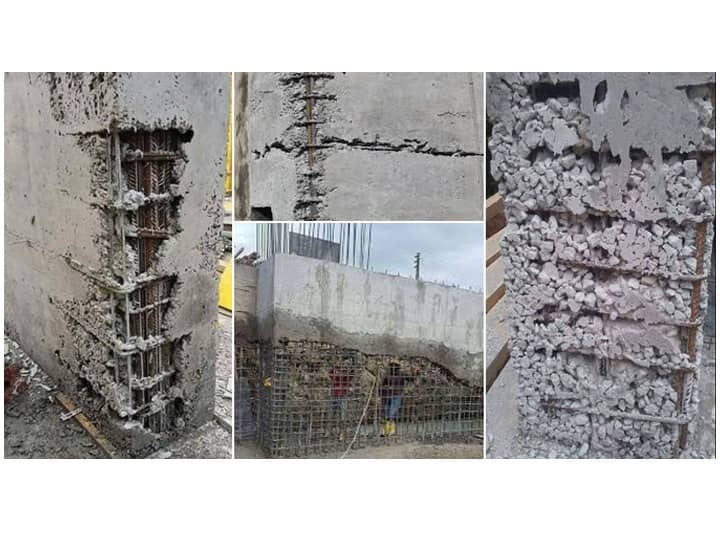Prevention & Remedies of Honeycombs in Concrete
Concrete is the most useful building material ever, but it has its downsides. One of the problems with concrete is the frequent corrosion issues it faces. Also, if the concrete is not applied properly, it may have problems One such problem is honeycombs in concrete, which are very damaging to the structure indeed. Today, we will discuss about the causes, prevention and remedies of honeycombs in concrete.
What does honeycomb in concrete look like
Honeycombs in concrete are a fashionable name given to a certain type of damages appearing on the surface of a concrete structure. You may see some pits on the concrete surface, empty areas, that look like as if the concrete has been gauged out of the surface. Sometimes, you may be able to see the reinforcements within. This is called honeycombs in concrete.
An extremely serious matters, honeycombs can be very damaging to the concrete. Obviously, it reduces the strength of the concrete. But not only that, if the reinforcement gets exposed due to the honeycombing, it will be unprotected from weathering effects such as oxidization and rusting. This will severely weaken or may even break the RCC member with the honeycombs.
Not only that. Honeycombs are often more than what they look - there are gaps under the honeycombs, air bubbles joined by microscopic tunnels. Water and moisture can get through this way into the concrete, and then corrode it from the inside.
For those reasons, concrete honeycombs must be taken very seriously and be treated at once they are found.
Why do honeycombs occur in concrete?
There are many reasons why honeycombs may occur in concrete. Some of the major reasons of concrete honeycombing are:
- Wrong workability: If the concrete was stiffer or harder than it was needed for the forces applied on that member, then the application process itself will be difficult. This will, in turn, cause honeycombs later.
- Extra water in the mix: Quite the opposite of the above is also possible. If you have added too much water, the aggregate may fall off the concrete mix when applied, leaving honeycombs.
- Improper vibration: If you apply too much vibration to the concrete, or if you don't take care what you're hitting while vibrating, then the concrete might leak through the formwork. In turn, that will leave room for the concrete to settle, and honeycombs will appear on surface.
- Too much height: if the concrete mix is fluid enough, don't apply it to build tall members. Because due to the gravitational pull, the aggregate may get separated from the rest and settle below, and then you'll not only have to work with an improper mix but also honeycombs at the higher side.
- Reinforcement lapping: When you are building joints like beam to beam or column to column, the reinforcements overlap. This dense jungle of reinforcement is difficult for the concrete to get into, and so air gaps remain inside the joints. It doesn't only weaken the joint but also later causes honeycombs.
- Improper aggregate ratio: If you are using too much coarse aggregates (>20mm) then they will make it difficult for the fine aggregate (10mm) to get through them inside the formwork. This will, like above, leave air gaps in the concrete and cause later settlement, causing honeycombs.
How do we prevent honeycombs from happening?
- a. Listen to the designer. The designer knows where what kind of concrete is needed, and deviating from that precise need is always dangerous.
- b. No-risk construction. Do not take any chances while making load-bearing members of the structure. Columns and beams especially vulnerable to this matter, and so you should take utmost care that none of the issues described above may occur while building them.
- c. Use fine aggregates at joints. Even if the designer didn't explicitly mention, you should use a mix with only small chips (less than 20mm) at the beam/column joints, and carefully vibrate. This should make sure the mix gets everywhere it needs to be and there are no places to settle.
- d. Tap the wood. While concreting, tap the outside of the formwork with wooden hammers or similar tools. This Makes sure the surface concrete is free of bubbles and greatly reduces honeycombing risk.
- e. Micro-vibrate. Use a 25mm or lesser needle for vibrating inside the reinforcement overlap points, to make sure they get the concrete inside the cages.
What to do when honeycombs appear on concrete
First, judge how severe they are. Depending upon their location or type, they are either weakening a joint, or just a member. If they are weakening a joint, then there is not much left to do other than completely replacing those members, a complete do-over.
If one member is being hurt lightly by the honeycombing, then you have some leeway. You can break off the part of the concrete that's affected (concrete with honeycomb area will break easily, indicating their weakness). When you are sure that you have cleared up the affected concrete, then you can apply adhesive material on the exposed surface, and recast the broken-off part.
